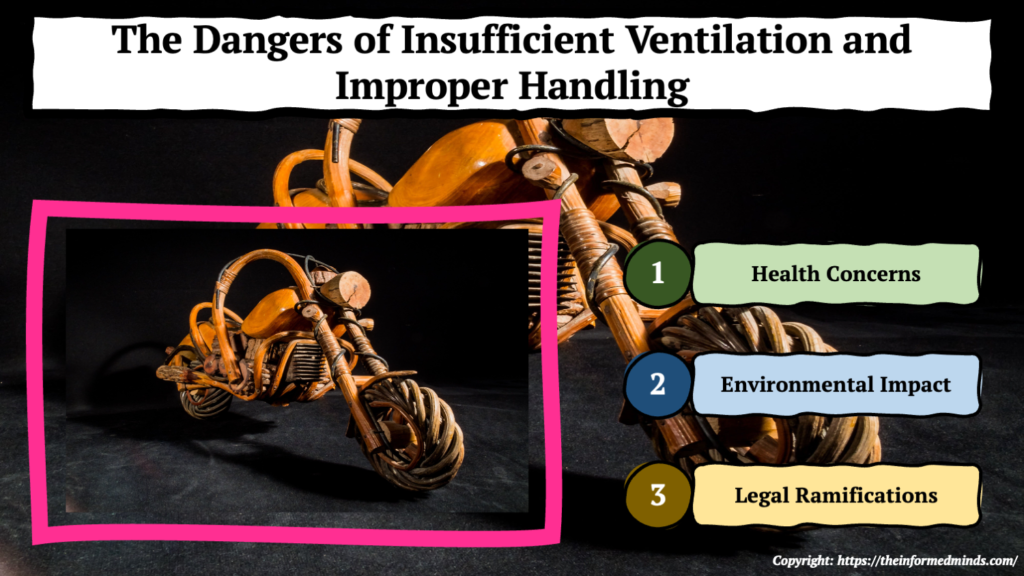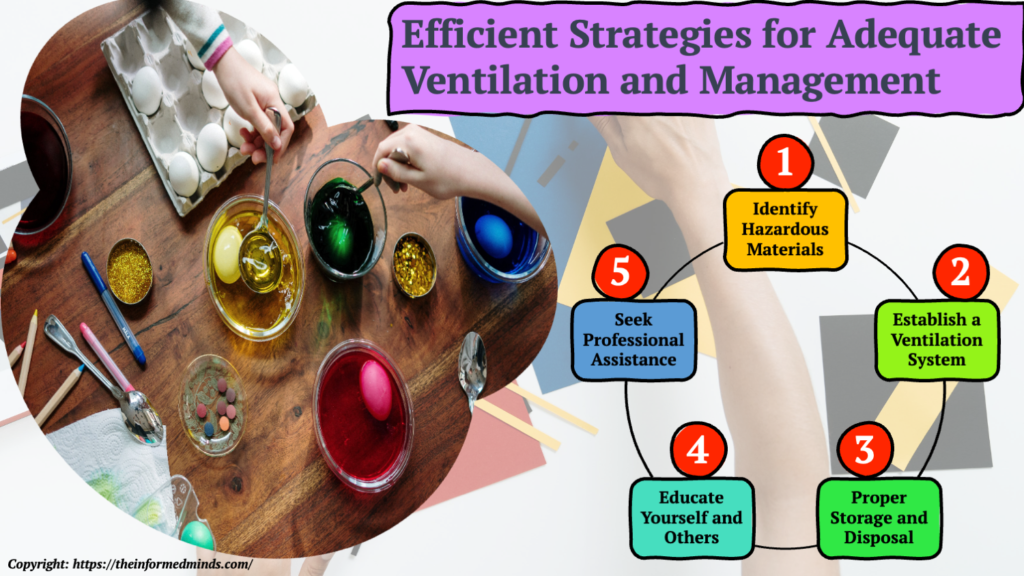To Share is to Show You Care!
DIY projects can be incredibly rewarding, offering a sense of accomplishment and satisfaction. However, there’s a critical aspect that many DIY enthusiasts overlook: the proper ventilation and handling of hazardous materials. Failing to address these concerns can lead to serious health risks. In this blog post, we’ll delve into the importance of ventilation and provide solutions to ensure safety during your next DIY venture.
1. The Risks of Inadequate Ventilation and Handling

1.1 Health Concerns
- Exposure Risks: When working with hazardous materials, such as paints, solvents, or adhesives, the fumes emitted can lead to respiratory problems. Prolonged exposure might result in chronic health issues like asthma, lung irritation, or even more severe conditions.
- Skin Irritation: Direct contact with certain chemicals or materials can cause skin rashes, burns, or allergic reactions, emphasizing the need for proper protective equipment and handling protocols.
1.2 Environmental Impact
- Pollution: Incorrect disposal methods, like pouring hazardous waste down drains or into the ground, can contaminate water sources, harm wildlife, and disrupt ecosystems. Chemical runoff can have long-lasting environmental consequences.
- Air Quality: Improper ventilation releases harmful pollutants into the air, contributing to outdoor and indoor air pollution, affecting not only your immediate surroundings but potentially broader areas.
1.3 Legal Ramifications
- Regulatory Compliance: Many jurisdictions have strict regulations governing the handling, storage, and disposal of hazardous materials. Failure to comply with these regulations can result in fines, penalties, or legal action.
- Liability: If mishandling of hazardous materials leads to health issues or environmental damage, you could face legal liabilities, including compensating affected parties or cleaning up contamination sites.
2. Effective Solutions for Proper Ventilation and Handling

2.1 Identify Hazardous Materials
- Research: Utilize product labels, manufacturer guidelines, and online resources to identify hazardous components in materials you plan to use. Understanding potential risks allows for informed decision-making and precautionary measures.
- Labels & MSDS: Material Safety Data Sheets (MSDS) provide detailed information on chemical composition, hazards, handling procedures, and emergency responses. Always review MSDS documents for materials to ensure safe usage and storage.
2.2 Establish a Ventilation System
- Natural Ventilation: Open doors, windows, or create cross-ventilation by strategically placing fans to allow fresh air to circulate. This method helps dilute indoor pollutants and reduce fume concentration.
- Mechanical Ventilation: Invest in exhaust fans, ventilation hoods, or specialized systems designed for hazardous materials. These systems remove contaminated air, ensuring a safer working environment.
- PPE: Personal Protective Equipment, such as respirators, masks, gloves, and goggles, acts as a barrier against harmful exposures. Choose PPE appropriate for the specific hazards you’re addressing.
2.3 Proper Storage and Disposal
- Sealed Containers: Store hazardous materials in well-sealed, labeled containers to prevent spills, leaks, or evaporation. Ensure containers are compatible with the stored material to avoid chemical reactions or degradation.
- Disposal Guidelines: Familiarize yourself with local, state, or federal disposal regulations. Utilize hazardous waste collection sites, recycling centers, or specialized disposal services to safely and legally dispose of materials.
2.4 Educate Yourself and Others
- Training: Engage in training programs, workshops, or online courses focusing on safe handling practices, ventilation techniques, and regulatory compliance.
- Share Knowledge: Communicate safety protocols, guidelines, and best practices with team members, family members, or anyone involved in the DIY project. Encourage open dialogue about potential risks and preventive measures.
2.5 Seek Professional Assistance
- Consult Experts: When uncertain about handling specific materials or implementing ventilation systems, consult with professionals, such as industrial hygienists, environmental consultants, or safety experts.
- Hire Services: For complex projects or large-scale operations, consider hiring specialized services. Professionals can provide expertise in hazardous material management, ventilation design, and regulatory compliance, ensuring a safer, more efficient project execution.
Conclusion
Prioritizing safety through proper ventilation and handling of hazardous materials is crucial for mitigating health risks, minimizing environmental impact, and avoiding legal repercussions. By understanding potential risks, implementing effective solutions, and adhering to safety protocols, you can create a secure DIY environment, fostering creativity, innovation, and responsible practices. Always remember, safety should remain at the forefront of any DIY endeavor, ensuring protection for yourself, others, and the environment.
Frequently Asked Questions
- What are the 10 basic rules for safety handling hazardous materials?
- Always read and understand the Material Safety Data Sheet (MSDS) for each hazardous material.
- Wear appropriate personal protective equipment (PPE) like gloves, goggles, and masks.
- Ensure adequate ventilation in the working area to minimize exposure to fumes or gases.
- Store hazardous materials in labeled containers away from incompatible substances.
- Use the material in a well-ventilated area and avoid inhalation or direct contact.
- Handle and transport hazardous materials with care, avoiding spills or leaks.
- Do not eat, drink, or smoke while handling hazardous materials.
- In case of spills or accidents, follow emergency procedures outlined in the MSDS.
- Dispose of hazardous waste according to local, state, and federal regulations.
- Regularly inspect storage areas for leaks, damage, or other potential hazards.
2. How could you protect yourself while you work with this hazardous material?
- Use appropriate personal protective equipment (PPE) such as gloves, goggles, respirators, and aprons.
- Work in well-ventilated areas or utilize local exhaust ventilation systems.
- Handle materials with care, avoiding direct contact or inhalation of fumes.
- Familiarize yourself with emergency procedures and safety guidelines for each material.
- Regularly wash hands and exposed skin after handling hazardous substances.
3. What kinds of precautions are taken at home when dealing with hazardous substances?
- Store hazardous substances in their original containers with proper labels.
- Keep hazardous materials out of reach of children and pets.
- Use products according to manufacturer’s instructions and avoid mixing chemicals.
- Dispose of household hazardous waste at designated collection sites or events.
- Educate family members about potential risks and safety precautions.
4. What does hazardous materials handling require?
Hazardous materials handling requires proper training, knowledge of potential risks, adherence to safety protocols, use of appropriate personal protective equipment (PPE), and compliance with regulatory requirements for storage, transportation, and disposal.
5. What are 5 things you can do to ensure safe handling of chemicals?
- Read and understand the Material Safety Data Sheet (MSDS) for each chemical.
- Wear appropriate personal protective equipment (PPE) like gloves, goggles, and aprons.
- Store chemicals in labeled containers away from incompatible substances.
- Use chemicals in well-ventilated areas and avoid direct contact or inhalation.
- Dispose of chemical waste according to local regulations and guidelines.
6. What are the safe handling of hazardous chemicals?
Safe handling of hazardous chemicals involves proper storage, transportation, usage, and disposal practices. This includes reading MSDS, wearing PPE, ensuring ventilation, preventing spills or leaks, and adhering to regulatory requirements.
7. What are the proper ways of handling materials?
Proper ways of handling materials include using appropriate equipment, wearing protective gear, following safety guidelines, storing materials correctly, avoiding contamination, and ensuring proper disposal methods.
8. What will you do to control hazardous effects of some household materials at home and in the environment?
To control hazardous effects, one should store materials properly, use them according to instructions, dispose of waste responsibly, educate family members about risks, utilize designated disposal sites, and promote environmentally-friendly practices.
9. What is the first step in handling chemicals safely?
The first step in handling chemicals safely is to read and understand the Material Safety Data Sheet (MSDS) to identify potential hazards, required precautions, and emergency procedures associated with the specific chemical.
10. What are 6 hazardous chemicals at home?
- Bleach (sodium hypochlorite)
- Ammonia-based cleaners
- Drain cleaners (sulfuric acid or lye)
- Oven cleaners (sodium hydroxide)
- Paints, solvents, and thinners
- Pesticides and insecticides
11. Why is proper labeling crucial when dealing with hazardous materials?
Proper labeling is essential because it provides critical information about the contents, potential hazards, handling instructions, and emergency procedures. Clear labeling ensures that individuals can identify and understand the risks associated with the material, facilitating safe storage, transportation, and usage.
12. How can one safely transport hazardous materials?
- Use Approved Containers: Transport hazardous materials in approved containers designed for specific substances, ensuring compatibility and preventing leaks.
- Secure Packaging: Ensure containers are tightly sealed, packaged securely, and placed in secondary containment systems like spill trays or bins.
- Follow Regulations: Adhere to transportation regulations, including placarding, labeling, documentation, and securing loads to prevent spills or accidents during transit.
- Use Protective Equipment: Wear appropriate PPE during transportation, such as gloves, goggles, and protective clothing, to minimize exposure risks.
13. What are the environmental considerations when handling hazardous materials?
- Prevent Contamination: Ensure hazardous materials do not contaminate soil, water, or air through spills, leaks, or improper disposal.
- Promote Recycling: Whenever possible, recycle hazardous materials or utilize eco-friendly alternatives to reduce environmental impact.
- Follow Disposal Guidelines: Dispose of hazardous waste according to environmental regulations, using designated disposal sites or services to minimize pollution and protect ecosystems.
14. How can one prepare for emergencies involving hazardous materials?
- Develop an Emergency Response Plan: Create a comprehensive plan outlining procedures, roles, communication methods, and resources required to address potential emergencies.
- Training and Drills: Conduct regular training sessions and emergency drills to educate personnel about response protocols, equipment usage, and evacuation procedures.
- Emergency Equipment: Maintain emergency response equipment like spill kits, fire extinguishers, first aid supplies, and decontamination stations to address incidents effectively.
- Communication: Establish communication protocols with local authorities, emergency services, and stakeholders to coordinate responses and ensure public safety.
15. What role does ventilation play in handling hazardous materials?
Ventilation plays a crucial role in handling hazardous materials by controlling exposure levels, removing contaminants, diluting fumes or gases, and maintaining a safe working environment. Proper ventilation systems, including exhaust fans, fume hoods, and air purification systems, help mitigate health risks and regulatory compliance.
The Informed Minds
I'm Vijay Kumar, a consultant with 20+ years of experience specializing in Home, Lifestyle, and Technology. From DIY and Home Improvement to Interior Design and Personal Finance, I've worked with diverse clients, offering tailored solutions to their needs. Through this blog, I share my expertise, providing valuable insights and practical advice for free. Together, let's make our homes better and embrace the latest in lifestyle and technology for a brighter future.

